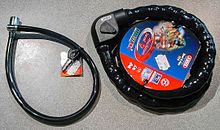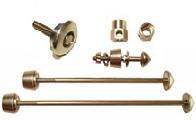| Revision as of 18:16, 13 June 2006 editVfgilber (talk | contribs)4 edits →Locking skewers← Previous edit | Revision as of 18:26, 13 June 2006 edit undoSCEhardt (talk | contribs)Extended confirmed users15,691 editsm →Locking skewers: fmtNext edit → | ||
| Line 32: | Line 32: | ||
| ==Locking skewers== | ==Locking skewers== | ||
| ] | |||
| Locking skewers replace the existing skewers on a bicycle's wheels and ] clamp. This reduces the need to lock these parts of the bike since they are now secured to the ]. One type of locking skewer uses the same design as a ], except after clamping the skewer the (]) handle may be removed. | Locking skewers replace the existing skewers on a bicycle's wheels and ] clamp. This reduces the need to lock these parts of the bike since they are now secured to the ]. One type of locking skewer uses the same design as a ], except after clamping the skewer the (]) handle may be removed. | ||
| Another type of locking skewer uses a uniquely-shaped nut that can only be turned using the matching socket/key. Though relatively more expensive, they provide the maximum in security possible (except for locking wheels with an additional U-Lock). This type of locking skewer can also be found for suspension forks, V-brakes, and solid-axle wheels in addition to regular wheels and seatposts. |
Another type of locking skewer uses a uniquely-shaped nut that can only be turned using the matching socket/key. Though relatively more expensive, they provide the maximum in security possible (except for locking wheels with an additional U-Lock). This type of locking skewer can also be found for suspension forks, V-brakes, and solid-axle wheels in addition to regular wheels and seatposts. | ||
| There is also a less expensive option. Many cyclists opt to replace standard skewers with skewers that need an ] to be opened, despite the fact that the wheel can still be removed with a simple Allen key. Despite this drawback they are effective as they are not a target for opportunists, needing an Allen key and more time to be removed. | There is also a less expensive option. Many cyclists opt to replace standard skewers with skewers that need an ] to be opened, despite the fact that the wheel can still be removed with a simple Allen key. Despite this drawback they are effective as they are not a target for opportunists, needing an Allen key and more time to be removed. | ||
Revision as of 18:26, 13 June 2006

A bicycle lock is a physical security device used on bicycles to prevent theft. They are generally used to fasten the bicycle to a bicycle rack or any immovable object.
An important difficulty in preventing the theft of a bicycle is that the wheels are easily detachable from the frame, and that unless the bicycle is attached to an immobile object it can easily be carried away. However, if only the frame is locked, a wheel or wheels may be stolen. The most secure locking systems therefore lock the wheels and frame to each other and to an immovable object.
Most portable locking devices need to be quite large and substantial to discourage serious theft. This makes them inconvenient and heavy. An alternate solution is the provision of lockable boxes where the whole bicycle is locked in. This safeguards other equipment such as lamps, tools, spare tubes etc.
U-locks and D-locks

A U-lock is a rigid metal ring in the shape of the letter U. The U part of the lock attaches to a crossbar section, and for this reason they are also called D-locks. To lock the bicycle, one either locks it physically to some other object, or locks the frame to the spokes of the wheel, rendering the entire bicycle immobile. A common brand name of U-lock is the Kryptonite lock.
Chain
A chain lock is a lockable chain. It often has a key or a combination lock attached to it. A long enough chain can pass through both wheels, the frame and attach the bicycle to an immovable object.
Chains vary widely in their security level. If the chain itself is simply purchased from a hardware store, it can easily be cut with a relatively inexpensive pair of bolt cutters. Chains specifically designed for use in locking bicycles are also available. These chains are made of a much harder metal and the links are often shaped in a manner that deters bolt cutters.
As the saying goes, a chain is only as strong as its weakest link, which may be the lock. Although a cheap keyed or combination lock would be an appropriate match for a hardware store chain, a specialized chain necessitates a specialized lock such as a mini u-lock. Many chains are far too big and heavy to be practically carried around by a cyclist, so it is common for cyclists to leave such chains permanently at a convenient location, such as near their place of work.
Cable locks

Cable locks are in many ways similar to chain locks. Cable locks often come with the locking mechanism already permanently integrated. Otherwise, a length of cable with loops on both ends can also be used.
The main advantage of cable locks over chains is the ease of transporting them. Many cable locks are made of spring cable that automatically coils itself when released. Even a straight cable can be coiled by the user into a more manageable shape than a chain.
Cable locks, however, are not secure. They are only sufficient for use in low-risk areas since even the largest diameter cable can be quickly cut with bolt cutters.
Many cyclists use a cable with loops on both ends to secure bicycle components such as the wheels or seat to a U-lock which is used to secure the frame.
Wheel lock
Also called an O-lock, this is a mechanism mounted on the frame that immobilises the rear wheel by moving a steel bolt through the spokes to prevent motion. It uses a straight or circular bolt which extends from the housing. This type of lock, found particularly on bicycles in Scandinavia, the Netherlands, and China, prevents riding the bicycle but does not secure the bicycle to a stationary object.
Locking skewers

Locking skewers replace the existing skewers on a bicycle's wheels and seatpost clamp. This reduces the need to lock these parts of the bike since they are now secured to the frame. One type of locking skewer uses the same design as a quick release skewer, except after clamping the skewer the (keyed) handle may be removed.
Another type of locking skewer uses a uniquely-shaped nut that can only be turned using the matching socket/key. Though relatively more expensive, they provide the maximum in security possible (except for locking wheels with an additional U-Lock). This type of locking skewer can also be found for suspension forks, V-brakes, and solid-axle wheels in addition to regular wheels and seatposts.
There is also a less expensive option. Many cyclists opt to replace standard skewers with skewers that need an Allen key to be opened, despite the fact that the wheel can still be removed with a simple Allen key. Despite this drawback they are effective as they are not a target for opportunists, needing an Allen key and more time to be removed.
Categories: